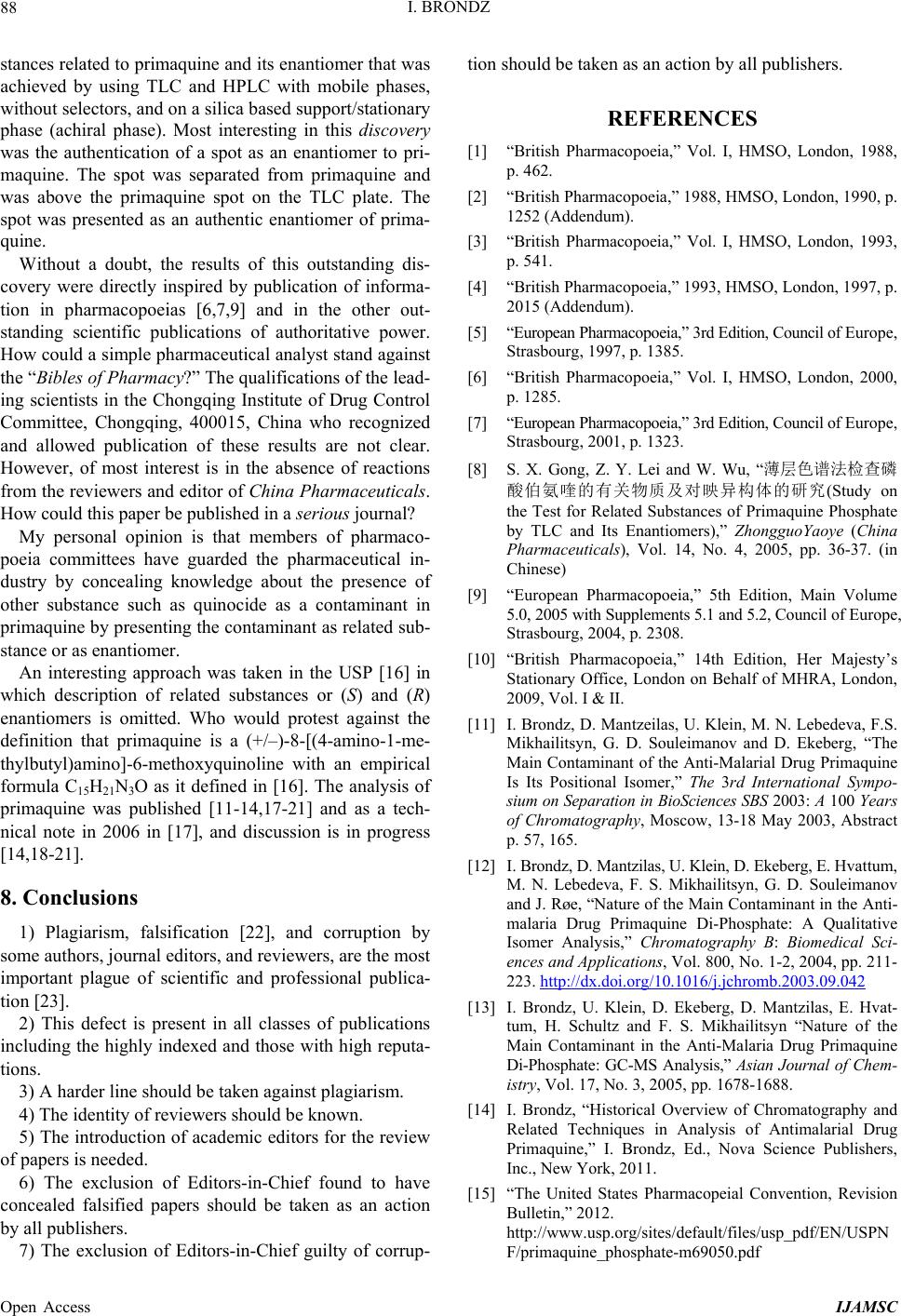
I. BRONDZ
88
stances related to primaquine and its enantiomer that was
achieved by using TLC and HPLC with mobile phases,
without selectors, and on a silica based support/statio nary
phase (achiral phase). Most interesting in this discovery
was the authentication of a spot as an enantiomer to pri-
maquine. The spot was separated from primaquine and
was above the primaquine spot on the TLC plate. The
spot was presented as an authentic enantiomer of prima-
quine.
Without a doubt, the results of this outstanding dis-
covery were directly inspired by publication of informa-
tion in pharmacopoeias [6,7,9] and in the other out-
standing scientific publications of authoritative power.
How could a simple pharmaceutical analyst stand against
the “Bibles of Pharmacy?” The qualifications of the lead-
ing scientists in the Chongqing Institute of Drug Control
Committee, Chongqing, 400015, China who recognized
and allowed publication of these results are not clear.
However, of most interest is in the absence of reactions
from the reviewers and editor of China Pharmaceuticals.
How could this paper be published in a serious journal?
My personal opinion is that members of pharmaco-
poeia committees have guarded the pharmaceutical in-
dustry by concealing knowledge about the presence of
other substance such as quinocide as a contaminant in
primaquine by presenting the contaminant as related sub-
stance or as enantiomer.
An interesting approach was taken in the USP [16] in
which description of related substances or (S) and (R)
enantiomers is omitted. Who would protest against the
definition that primaquine is a (+/–)-8-[(4-amino-1-me-
thylbutyl)amino]-6-methoxyquinoline with an empirical
formula C15H21N3O as it defined in [16]. The analysis of
primaquine was published [11-14,17-21] and as a tech-
nical note in 2006 in [17], and discussion is in progress
[14,18-21].
8. Conclusions
1) Plagiarism, falsification [22], and corruption by
some authors, journal editors, and reviewer s , a r e the most
important plague of scientific and professional publica-
tion [23].
2) This defect is present in all classes of publications
including the highly indexed and those with high reputa-
tions.
3) A harder line should be taken against plagiarism.
4) The identity of reviewers should be known.
5) The introduction of academic editors for the review
of papers is needed.
6) The exclusion of Editors-in-Chief found to have
concealed falsified papers should be taken as an action
by all publishers.
7) The exclusion of Editors-in-Chief guilty of corrup-
tion should be taken as an action by all publishers.
REFERENCES
[1] “British Pharmacopoeia,” Vol. I, HMSO, London, 1988,
p. 462.
[2] “British Pharmacopoeia,” 1988, HMSO, London, 1990, p.
1252 (Addendum).
[3] “British Pharmacopoeia,” Vol. I, HMSO, London, 1993,
p. 541.
[4] “British Pharmacopoeia,” 1993, HMSO, London, 1997, p.
2015 (Addendum).
[5] “European Pharmacopoeia,” 3rd Edition, Council of Euro p e,
Strasbourg, 1997, p. 1385.
[6] “British Pharmacopoeia,” Vol. I, HMSO, London, 2000,
p. 1285.
[7] “European Pharmacopoeia,” 3rd Edition, Council of Euro p e,
Strasbourg, 2001, p. 1323.
[8] S. X. Gong, Z. Y. Lei and W. Wu, “薄层色谱法检查磷
酸伯氨喹的有关物质及对映异构体的研究(Study on
the Test for Related Substances of Primaquine Phosphate
by TLC and Its Enantiomers),” ZhongguoYaoye (China
Pharmaceuticals), Vol. 14, No. 4, 2005, pp. 36-37. (in
Chinese)
[9] “European Pharmacopoeia,” 5th Edition, Main Volume
5.0, 2005 with Supplements 5.1 a nd 5.2, Co uncil of Eu rope,
Strasbourg, 2004, p. 2308.
[10] “British Pharmacopoeia,” 14th Edition, Her Majesty’s
Stationary Office, London on Behalf of MHRA, London,
2009, Vol. I & II.
[11] I. Brondz, D. Mantzeilas, U. Klein, M. N. Lebedeva, F.S.
Mikhailitsyn, G. D. Souleimanov and D. Ekeberg, “The
Main Contaminant of the Anti-Malarial Drug Primaquine
Is Its Positional Isomer,” The 3rd International Sympo-
sium on Separation in BioSciences SBS 20 03: A 100 Years
of Chromatography, Moscow, 13-18 May 2003, Abstract
p. 57, 165.
[12] I. Brondz, D. Mantzilas, U. Klein, D. Ekeberg, E. Hvattum,
M. N. Lebedeva, F. S. Mikhailitsyn, G. D. Souleimanov
and J. Røe, “Nature of the Main Contaminant in the Anti-
malaria Drug Primaquine Di-Phosphate: A Qualitative
Isomer Analysis,” Chromatography B: Biomedical Sci-
ences and Applications, Vol. 800, No. 1-2, 2004, pp. 211-
223. http://dx.doi.org/10.1016/j.jchromb.2003.09.042
[13] I. Brondz, U. Klein, D. Ekeberg, D. Mantzilas, E. Hvat-
tum, H. Schultz and F. S. Mikhailitsyn “Nature of the
Main Contaminant in the Anti-Malaria Drug Primaquine
Di-Phosphate: GC-MS Analysis,” Asian Journal of Chem-
istry, Vol. 17, No. 3, 2005, pp. 1678-1688.
[14] I. Brondz, “Historical Overview of Chromatography and
Related Techniques in Analysis of Antimalarial Drug
Primaquine,” I. Brondz, Ed., Nova Science Publishers,
Inc., New York, 2011.
[15] “The United States Pharmacopeial Convention, Revision
Bulletin,” 2012.
http://www.usp.org/sites/default/files/usp_pdf/EN/USPN
F/primaquine_phosphate-m69050.pdf
Open Access IJAMSC